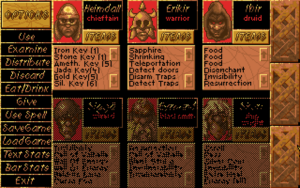Evolution: Environment and Migration
I’m still consistently losing. Or rather, consistently giving up when it’s clear I’m going to lose. I’ve started loosening up a bit with regards to deciding when that is, though. It doesn’t do to be too disheartened at the opponents beating you out to evolving a new species: in order for it to do them any good, they have to keep it from going extinct. And most new species have a bit of a handicap there, in that their ideal environment isn’t the same as that of the species that spawned it — that being more or less the point of speciation.
Environment has two components: terrain and temperature. The unit description window — the same one that indicates a unit’s population and how well it’s feeding — mentions the ideal terrain type and temperature for that unit’s species; more detailed information, including how well it survives in each terrain, is available in the species details. It’s easy to fall into the trap of paying attention only to the terrain type, because that’s highly visible: every tile on the map is decorated according to its terrain. But the temperature seems to be even more important to survival, and it’s displayed in a place that users tend to ignore: the info bar at the bottom of the window. It displays the temperature and terrain type for the tile currently pointed at by the mouse pointer — which is to say, it only starts to display useful information when you’re looking at a different part of the screen. It’s invaluable once you start paying attention to it, but I feel like the fact that the info bar is used at all, let alone for such a crucial feature, is a real sign of how new the idea of Windows as a gaming platform was. People didn’t really know how to use it, but they were willing to experiment.
So, when you get a new species, it’s a fragile thing, ill-adapted to its environment and in need of nurturing. Which is kind of the opposite of how evolution is supposed to work, but regardless, the top priority is to get it to its ideal environment before it dies out. Even once it’s there, the environment doesn’t last forever. Plains turn to desert, mountains rise, the climate changes — sometimes catastrophically, as in a major asteroid strike. About all you can do is send your creatures to as many different places as possible and hope for the best. Which you want to do anyway: you don’t want your creatures competing with each other for food. (In extreme cases, I’ve contemplated marching my obsolete creatures into the ocean to make room for the new guys.) No, you want them competing with the opponets’ creatures for food. My greatest competitive successes so far have not been a matter of out-evolving the opponents, or of fighting and killing them, but of driving them away by out-breeding and out-eating them. Which is how invasive species work in real life, so hooray for accuracy.
Spreading your population out isn’t trivial, though. In order to get a unit from one ideal feeding ground to another, you typically have to cross areas not suited to the unit’s needs at all, and while it’s crossing those zones, its population will drop. This is how oceans work, by the way. You can send any species on a trek across the water, and it’ll just walk on it like it’s a blue carpet, not even slowing down. But while it’s out there, it won’t get any food at all. Birds can colonize remote continents more easily than most creatures, but that’s not because they have any kind of in-game-modeled flight attributes. It’s because they can move faster, and thus can cross more ocean before starving to death.
 Comments(0)
Comments(0)